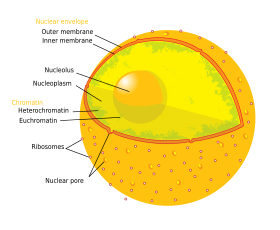
Back Membrana nucleyar AN غلاف نووي Arabic Nüvə qabığı Azerbaijani Ядрена обвивка Bulgarian নিউক্লিয়ার ঝিল্লি Bengali/Bangla Jedarna membrana BS Membrana nuclear Catalan Jaderná membrána Czech Kernemembran Danish Kernhülle German
| Nuclear envelope | |
|---|---|
 Human cell nucleus | |
| Identifiers | |
| TH | H1.00.01.2.01001 |
| FMA | 63888 |
| Anatomical terminology | |
The nuclear envelope, also known as the nuclear membrane,[1][a] is made up of two lipid bilayer membranes that in eukaryotic cells surround the nucleus, which encloses the genetic material.
The nuclear envelope consists of two lipid bilayer membranes: an inner nuclear membrane and an outer nuclear membrane.[4] The space between the membranes is called the perinuclear space. It is usually about 10–50 nm wide.[5][6] The outer nuclear membrane is continuous with the endoplasmic reticulum membrane.[4] The nuclear envelope has many nuclear pores that allow materials to move between the cytosol and the nucleus.[4] Intermediate filament proteins called lamins form a structure called the nuclear lamina on the inner aspect of the inner nuclear membrane and give structural support to the nucleus.[4]
- ^ Georgia State University. "Cell Nucleus and Nuclear Envelope". gsu.edu. Archived from the original on 2018-06-18. Retrieved 2014-01-21.
- ^ "Nuclear membrane". Biology Dictionary. Biology Online. Retrieved 7 December 2012.
- ^ "nuclear membrane". Merriam Webster. Retrieved 7 December 2012.
- ^ a b c d Alberts, Bruce (2002). Molecular biology of the cell (4th ed.). New York [u.a.]: Garland. p. 197. ISBN 978-0815340720.
- ^ "Perinuclear space". Dictionary. Biology Online. Retrieved 7 December 2012.
- ^ Berrios, Miguel, ed. (1998). Nuclear structure and function. San Diego: Academic Press. p. 4. ISBN 9780125641555.
Cite error: There are <ref group=lower-alpha> tags or {{efn}} templates on this page, but the references will not show without a {{reflist|group=lower-alpha}} template or {{notelist}} template (see the help page).